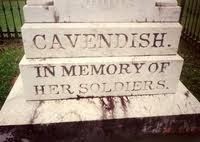Charles Dicken’s, the author of "A Christmas Carol," embraced what he called his Carol
Philosophy, - "a good time: a kind, forgiving,
charitable, pleasant time: the only time I know of in the long calendar of the
year, when men and women seem by one consent to open their shut-up hearts
freely, and to think of other people below them as if they really were
fellow-passengers to the grave, and not another race of creatures bound on
other journeys." With this idea, is it not surprising that his writing, combined with the reign of Queen Victoria, helped to ignite many of the Christmas traditions we celebrate today.
As
part of several Cavendish Historical Society (CHS) projects (Young Historians,
Hands on History and Honoring Our Heritage) we will be offering a series of
workshops at the Cavendish Town Elementary School (CTES) in December- “A Dickens of a Christmas.”
This
theme was chosen as many of the people who came to Cavendish
in the 1800s were English; the origins of many of our Christmas traditions stem
from the Victorian era; and the children were the ones who would start
preparing months in advance for the holiday, making many of the ornaments for
the tree.
Each grade will be doing something different: gilding pine cones, creating
fortune walnuts, cornucopias, and paper flowers and collecting greens from school property for swags and center pieces.
In
true Victorian era fashion, CHS is seeking donations of the following:
- Scraps of ribbon, lace
- Gold, silver or white
paint
- Inexpensive paint
brushes
- Glitter
- Old Christmas Cards
- Glass vases for
centerpieces.
If you have items to donate, they can be dropped off at the school office, or bring them to the CHS booth at the Nov. 30 Holiday Fair (Saturday), which is from 9-3 at CTES. If you would like to help with the various workshops, please call 802-226-7807 or e-mail margoc@tds.net
Below are resources to help you learn more about the Victorian Christmas.
• The Victorian
House:
The extent and type of decorations would have depended on income and the year
(the era lasted from 1837 to 1901). While the Royal family’s tree was
resplendent with lots of bows, ribbons, and lush ornaments, the average family
tree would have reflected the talents of the children of the family, what was
available in Mom’s scrap basket and what grew in the area. With the advent of
the industrial age, glass ornaments became popular and fairly affordable for
families, still their trees would have contained paper chains, garlands of
popcorn and holly berries, cornucopias made from heavy paper, painted pine cones
and the traditional gilded walnuts. The latter were opened on New Year’s Day to
yield a fortune.
Wreaths,
swags and centerpieces made from local greens, fruit, nuts, bows and whatever
else was available adorned the various rooms in the house. While small presents were hung on the
tree, the gift was the Christmas feast itself.
• Christmas in New
England:
It
is interesting to note that “A Night Before Christmas” was first published in
1823 in Troy, NY. This poem, which provided America with its idea of Santa
Claus, was heavily based on the Dutch traditions of that era.
• Make Your Own Victorian Christmas:
This BBC series includes activities, history, and links to their series “The
Victorian Farm at Christmas.”
• “A Christmas Carol” by Charles Dickens,
published in 1843, helped to popularize the holiday both in England and the
United States.
-
- The Musical full production from 2004. Considered to be 98% accurate to the book
• Other Dickens Christmas
stories.
Several to consider include:
 • First Christmas Card: The first card was
sent in 1843, when Sir Henry Cole decided he was too busy to write individual
Christmas greetings. He had his friend, the painter John Horsley, design a card
that he could mail instead. Learn more at http://mentalfloss.com/article/26650/first-christmas-card-was-sent-1843
• First Christmas Card: The first card was
sent in 1843, when Sir Henry Cole decided he was too busy to write individual
Christmas greetings. He had his friend, the painter John Horsley, design a card
that he could mail instead. Learn more at http://mentalfloss.com/article/26650/first-christmas-card-was-sent-1843
• Games were very popular during the
Victorian era. After Christmas dinner, the family would often play a
variety of different games. Check the following resources:
 • Caroling: The Victorian era saw the revival of the
medieval tradition of caroling. Many of our carols come from this era including
"O Little Town of Bethlehem", "Good
Christian Men Rejoice", "Silent Night", "It Came Upon a
Midnight Clear", "Away in a Manger", "We Three King,”
"Jingle Bells," and “I Heard the Bells on Christmas Day.”
• Caroling: The Victorian era saw the revival of the
medieval tradition of caroling. Many of our carols come from this era including
"O Little Town of Bethlehem", "Good
Christian Men Rejoice", "Silent Night", "It Came Upon a
Midnight Clear", "Away in a Manger", "We Three King,”
"Jingle Bells," and “I Heard the Bells on Christmas Day.” 





